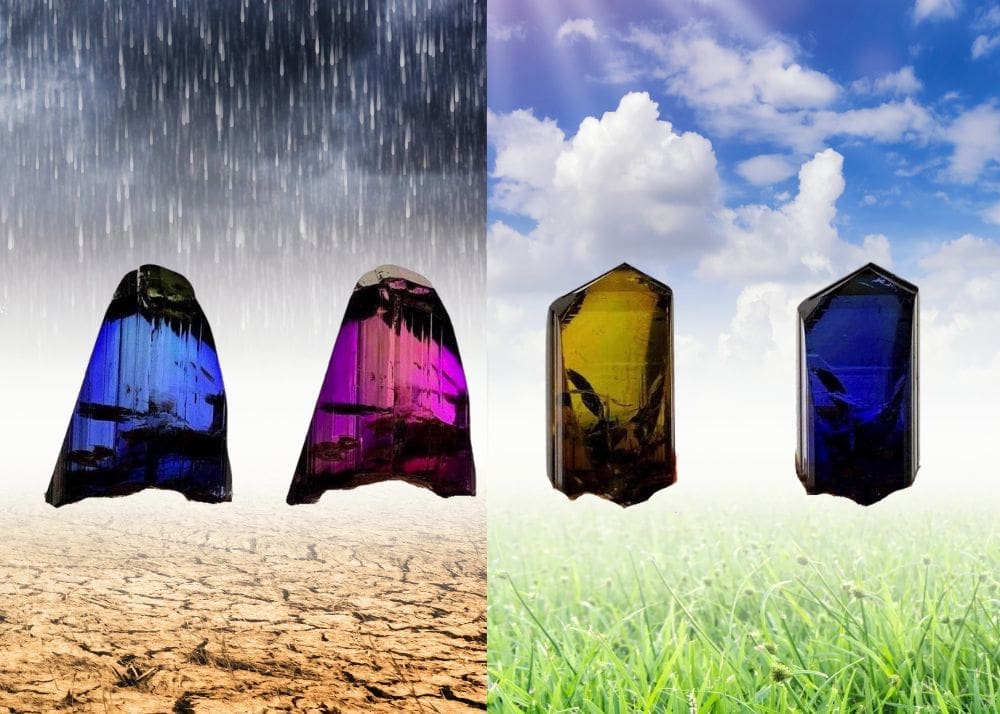Color-Changing Minerals: Marvels of the Mineral Kingdom
Introduction
Delving into the world of Color-Changing Minerals unveils a spectrum of geological stories. These minerals reveal an impressive characteristic: they alter their color when exposed to light, temperature changes, or chemical reactions. This phenomenon is not only a fascinating subject for mineralogists but also for anyone captivated by the beauty and mysteries of the Earth’s treasures.
The Science Behind the Spectrum
The science of Color-Changing Minerals is as intriguing as the spectacle itself. This color shift can occur due to a range of factors, including the presence of impurities within the mineral, the impact of light absorption, or the influence of heat. Such transformations may enhance the mineral’s aesthetic appeal and value, attracting collectors and gem enthusiasts worldwide.
Witnessing Color Transitions
Examples of Color-Changing Minerals are widespread and diverse. Topaz, known for its durability and clarity, often changes from a warm brown or yellow to an alluring blue when subjected to daylight, while some specimens can lose their color entirely. Similarly, green fluorite from England is famous for its ability to develop a purple hue under sun exposure—a sought-after trait for those passionate about unique mineral specimens.
Table of Transformative Minerals
Here is a relational table that illustrates several minerals known for their color-changing ability, the locations where they are typically found, and the nature of their transformation:
| Mineral | Location | Color Change | Source |
|---|---|---|---|
| Topaz (Brown/Yellow) | Japan | Turns blue in daylight | Text Provided |
| Topaz (Blue) | Japan | Becomes colorless in daylight | Text Provided |
| Topaz (Sherry-colored) | Thomas Range, Utah | Not specified | Text Provided |
| Fluorite (Green) | Weardale, County Durham | Changes to purple in sunlight | Text Provided |
| Quartz (Rose) | Varies | Fades in sunlight | Text Provided |
| Sapphire | Sri Lanka | From blue to violet in different lighting | Online |
| Amethyst | Brazil | Color intensity changes in sunlight | Online |
| Alexandrite | Russia | Changes color based on light source | Online |
Implications for Collectors and Gem Traders
For collectors and traders, the allure of Color-Changing Specimens lies not only in their beauty but also in their potential to transform over time. The phenomenon adds a layer of complexity to the gem trading market, where the mineral’s color at a given time can significantly influence its market value.
Discovering Color Changing Rocks at Miamiminingco.com
At Miamiminingco.com, enthusiasts can immerse themselves in the captivating world of minerals. Whether you’re drawn to the idea of mining your own gems or you wish to acquire unique mineral specimens, this site serves as a hub for discovery and appreciation of nature’s colorful artistry.
Conclusion: Embracing Natural Artistry
In conclusion, these types of Minerals offer a window into the dynamic and transformative nature of the Earth’s resources. These minerals remind us that beauty is not static but often enhanced by change. For those looking to explore these natural wonders, Miamiminingco.com provides the perfect starting point, with its wide array of gem mining buckets and Rock and Mineral specimens ready for collection.
10 FAQs:
- What causes minerals to change color?
- Color changes in minerals are usually due to environmental factors such as light exposure, temperature variations, or chemical reactions that affect the mineral’s structure or composition.
- Can the color change in minerals be reversed?
- For some minerals, the color change is reversible and depends on the specific environmental conditions. For example, certain topaz can revert to its original color when removed from sunlight.
- Are color-changing specimens rare?
- While not all minerals have the ability to change color, those that do are considered unique and are valued for their rarity and beauty.
- Does the color change in minerals affect their value?
- Yes, the ability to change color can greatly affect a mineral’s value, making it more appealing to collectors and gem enthusiasts.
- What are some examples of color-changing Rocks and Minerals?
- Examples include topaz that changes from brown or yellow to blue, fluorite that can turn purple under sunlight, and sapphire which can show different colors in various lighting.
- Where can I find color-changing minerals?
- Color-changing rocks can be found in specific locations around the world, such as Japan, Brazil, Russia, and the Thomas Range in Utah.
- How can I see a mineral change color?
- Observing a mineral change color can be done by exposing it to different lighting conditions, such as moving it from shade to sunlight, or by changing the temperature.
- Are all color changes in minerals caused by sunlight?
- Sunlight is a common factor, but not the only one. Changes can also occur due to other sources of light, heat, or internal chemical reactions.
- Can I buy color-changing rock?
- Yes, you can purchase color-changing specimen from specialized gem and mineral shops or online platforms like Miamiminingco.com.
- How should I care for my color-changing specimens?
- Care for color-changing minerals by protecting them from extreme or prolonged exposure to light and heat, which can alter or fade their colors. It’s also important to store them in a stable environment to preserve their natural beauty.

